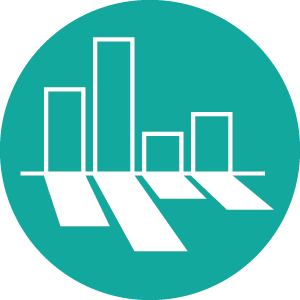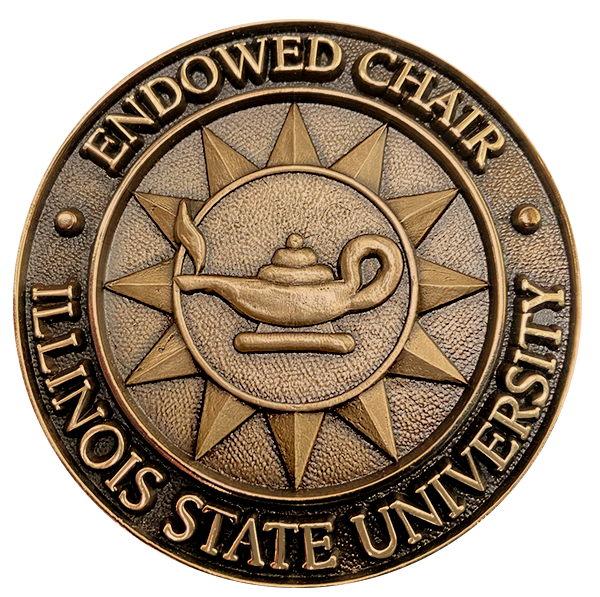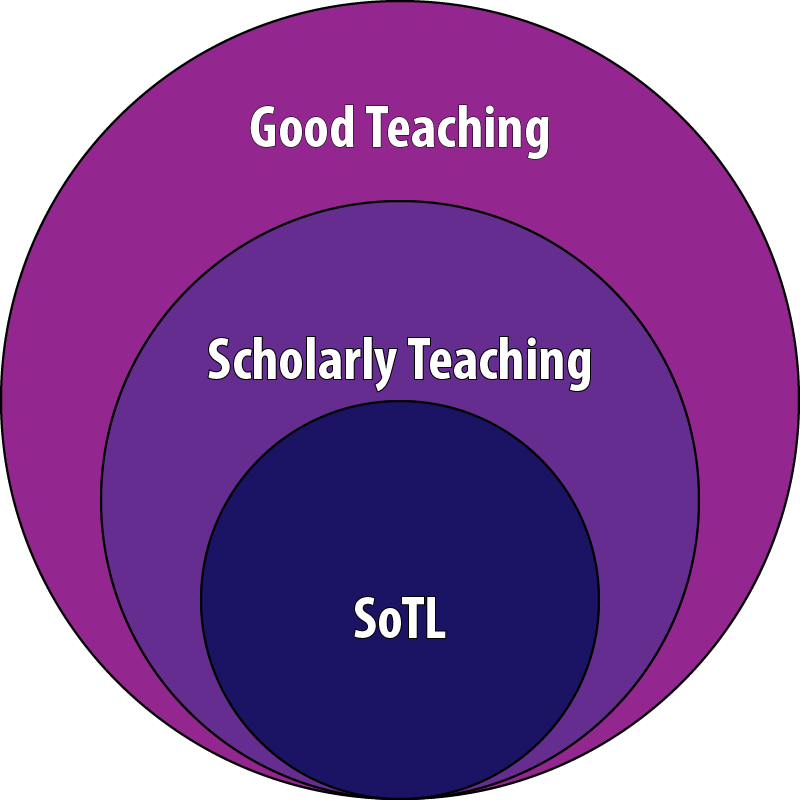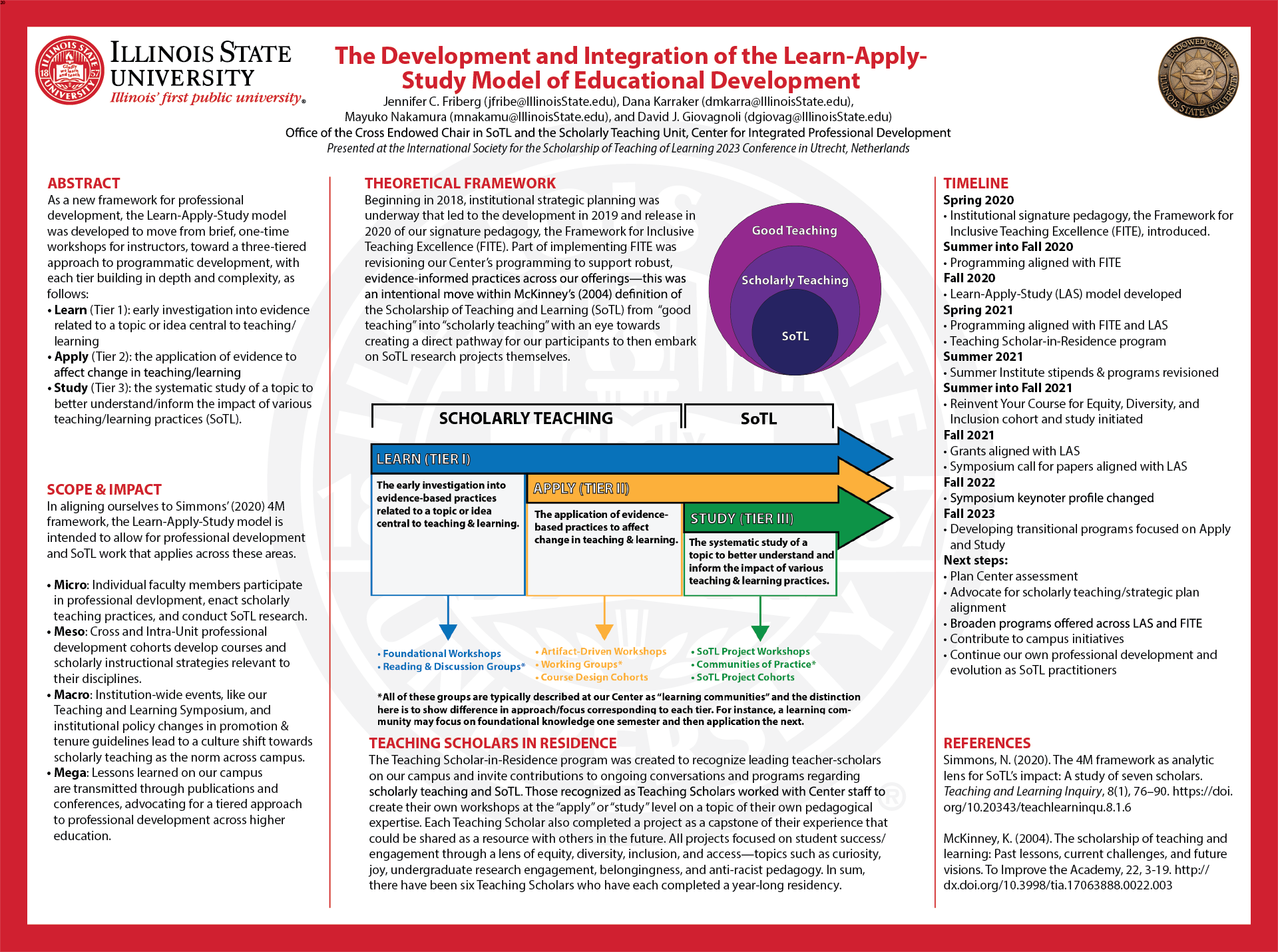As conceptualized by Kathleen McKinney in 2004, the Scholarship of Teaching and Learning exists in a relationship with good teaching and scholarly teaching. Good teaching is teaching that effectively meets the goals of learners and institutions, often learned through intuition or consultations with colleagues. Scholarly teaching goes beyond intuition to treating teaching like other forms of scholarship—a scholarly teacher goes to the literature to find what evidence-informed practices are most effective in their field and implements them systematically, alongside reflection on their praxis. Practicing SoTL is, most simply, going from a consumer of scholarship about teaching and learning to producing it. Practicing SoTL requires practicing scholarly teaching, and practicing scholarly teaching requires practicing good teaching. Scholarly teaching can also be seen as a form of applied SoTL.

The Scholarship of Teaching and Learning.
An introduction to the history and theory of the Scholarship of Teaching and Learning (SoTL), with resources for faculty to embark on SoTL projects at Illinois State.
The Scholarship of Teaching and Learning (SoTL) is a natural extension of data-informed reflection. At Illinois State University, SoTL is the “systematic reflection/study on teaching and learning [of ISU students] made public” (Office of the Cross Chair). Instructors investigate questions from their own classrooms and share findings through presentations, publications, performances, or other scholarly outputs. SoTL is recognized at ISU as research/creative activity aligned with institutional priorities and evaluation guidelines.
Educational Research, SoTL, and DBER
While educational research and the Scholarship of Teaching and Learning (SoTL) both aim to improve educational practice, they differ in focus and context: educational research is a broad field that investigates learning, teaching, and educational systems across all levels, often using a range of methodologies—including large-scale studies and participatory action research. SoTL, by contrast, is always situated within higher education and centers on systematic inquiry into teaching and learning in college or university settings, typically driven by practitioners seeking to enhance their own and others’ practice. However, the distinction is not strictly binary; SoTL projects can include high-N, multi-site studies, and educational research can be deeply participatory and context-specific. Both approaches contribute valuable insights, sometimes overlapping in methods and aims, but are distinguished by their typical contexts and primary audiences.
Discipline-Based Education Research (DBER) is a specialized field that investigates teaching and learning within specific academic disciplines, most commonly in STEM fields. DBER combines deep disciplinary expertise with educational research methods to develop evidence-based strategies and generalizable insights for improving student learning in particular subjects.
The History of SoTL
The modern field of SoTL began with Ernest Boyer’s Scholarship Reconsidered (1990), which called for a broader understanding of academic scholarship and elevated teaching to a scholarly activity alongside research, integration, and application. Expanding from Boyer’s foundation, the late 1990s and early 2000s saw the publication of Scholarship Assessed (Glassick, Huber, and Maeroff, 1997), which established standards for evaluating scholarly work, including teaching. The Carnegie Foundation’s Academy for the Scholarship of Teaching and Learning (CASTL), launched in 1998, provided a national and international platform for SoTL, fostering networks and supporting faculty inquiry into teaching and learning. Seminal articles by Pat Hutchings and Lee Shulman, such as “The Scholarship of Teaching: New Elaborations, New Developments” (1999), clarified the distinction between scholarly teaching and SoTL, emphasizing systematic inquiry, public sharing, and peer review as hallmarks of the field.
As SoTL matured, it expanded across disciplines and institutions, with the founding of multidisciplinary journals and the International Society for the Scholarship of Teaching and Learning (ISSOTL) in 2004. Works like Hutchings’ Opening Lines (2000) and Huber and Hutchings’ The Advancement of Learning (2005) helped define the teaching commons and the collaborative nature of SoTL. More recent texts, such as Nancy Chick’s SoTL in Action (2018) and Going Public Reconsidered (Chick and Friberg, 2022), reflect the field’s growing emphasis on practical impact, public engagement, and the diversity of SoTL approaches. Principles of good SoTL practice, articulated by scholars like Peter Felten (2013), now guide inquiry: focusing on student learning, grounding research in context, using sound methodology, partnering with students, and making results appropriately public.
SoTL at Illinois State
 Illinois State University has played a nationally recognized role in advancing SoTL, thanks to the leadership of scholars like Kathleen McKinney and Jennifer Friberg. ISU’s Office of the Cross Endowed Chair in SoTL remains the first and only University-wide endowed chair of its kind in the world and has provided mentorship, funding, and institutional support for faculty and student research. This office has helped define SoTL as “systematic reflection/study on teaching and learning [of ISU students] made public.” ISU faculty have contributed influential publications, frameworks, and resources, and the university hosts an internal peer-reviewed SoTL journal.
Illinois State University has played a nationally recognized role in advancing SoTL, thanks to the leadership of scholars like Kathleen McKinney and Jennifer Friberg. ISU’s Office of the Cross Endowed Chair in SoTL remains the first and only University-wide endowed chair of its kind in the world and has provided mentorship, funding, and institutional support for faculty and student research. This office has helped define SoTL as “systematic reflection/study on teaching and learning [of ISU students] made public.” ISU faculty have contributed influential publications, frameworks, and resources, and the university hosts an internal peer-reviewed SoTL journal.
Office of the Cross Endowed Chair in SoTL
The Office of the Cross Endowed Chair provides university‑wide leadership for SoTL at Illinois State. It champions rigorous, ethical inquiry into teaching and learning, strengthens dissemination of SoTL, and collaborates closely with CIPD to expand programming and faculty support.
What the Office Provides
CIPD Supporting SoTL
All of CIPD’s programming related to teaching is ultimately SoTL-informed, or otherwise informed by evidence-driven studies about teaching and learning, which is at the level of scholarly teaching or applied SoTL.
Learn-Apply-Study Model
At the Center, we organize our professional development events by whether the primary goal is learning, application, or study of the underlying concept presented. This structure allows our constituents to gradually go deeper with their learning and study of various pedagogical questions, starting by applying the existing literature and later being positioned to study it themselves. The following table is adapted from work presented by Scholarly Teaching team members at the International Society for the Scholarship of Teaching and Learning in 2023.
-
Learn (Tier 1)
The early investigation into evidence-based practices related to a topic or idea central to teaching and learning.
Foundational Workshops
Reading and Discussion Groups*
-
Apply (Tier 2)
The application of evidence-based practices to affect change in teaching and learning.
Artifact-Driven Workshops
Working Groups*
Course Design Cohorts
-
Study (Tier 3)
The systematic study of a topic to better understand and inform the impact of various teaching and learning practices.
SoTL Project Workshops
Communities of Practice*
SoTL Project Cohorts
ISSOTL 2023 Poster
References
Boyer, E. L. (1990). Scholarship reconsidered: Priorities of the professoriate. Princeton, NJ: The Carnegie Foundation for the Advancement of Teaching.
Brandriet, A., and Nasrollahian, S. (2025, September 10). What is SoTL? University of Iowa, Center for Teaching. https://teaching.center.uiowa.edu/news/2025/09/what-sotl
Chick, N. L. (2018). SoTL in action: Illuminating critical moments of practice. Stylus Publishing.
Chick, N. L., and Friberg, J. C. (2022). Going public reconsidered: Engaging with the world beyond academe through the scholarship of teaching and learning. Stylus Publishing.
Columbia University—SOLER. (n.d.). SoTL research basics. Columbia University. https://soler.columbia.edu/sotl-research-basics
Cruz, L., Steiner, H. H., and Cruz, C. (2024). Signature moves? An environmental scan of the intersection between educational development and SoTL. International Journal for the Scholarship of Teaching and Learning, 18(2), Article 2. https://doi.org/10.20429/ijsotl.2024.180202
Felten, P. (2013). Principles of good practice in SoTL. Teaching and Learning Inquiry: The ISSOTL Journal, 1(1), 121–125. https://files.eric.ed.gov/fulltext/EJ1149965.pdf
Glassick, C. E., Huber, M. T., and Maeroff, G. I. (1997). Scholarship assessed: Evaluation of the professoriate. San Francisco, CA: Jossey-Bass.
Gurung, R. A. R., and WilsonDoenges, G. (2013). Benchmarks for scholarly investigations of teaching and learning. Australian Journal of Psychology, 65(2), 63–70. https://doi.org/10.1111/ajpy.12011
Huber, M. T., and Hutchings, P. (2005). The advancement of learning: Building the teaching commons. Jossey-Bass.
Hutchings, P. (Ed.). (2000). Opening lines: Approaches to the scholarship of teaching and learning. Carnegie Foundation for the Advancement of Teaching.
Hutchings, P., Huber, M. T., and Ciccone, A. (2011). The scholarship of teaching and learning reconsidered: Institutional integration and impact. Jossey-Bass.
Hutchings, P., and Shulman, L. S. (1999). The scholarship of teaching: New elaborations, new developments. Change: The Magazine of Higher Learning, 31(5), 10–15. https://doi.org/10.1080/00091389909604218
International Society for the Scholarship of Teaching and Learning (ISSOTL). (n.d.). About ISSOTL / What is SoTL? https://issotl.com/
Mackenzie, J., and Meyers, A. (2012). International collaboration in SoTL: Current status and future direction. International Journal for the Scholarship of Teaching and Learning, 6(1), Article 4. https://doi.org/10.20429/ijsotl.2012.060104
MillerYoung, J., and Chick, N. L. (Eds.). (2024). Becoming a SoTL scholar. Center for Engaged Learning (open access). https://www.centerforengagedlearning.org/books/becoming-a-sotl-scholar/
McKinney, K. (2004). The scholarship of teaching and learning: Past lessons, current challenges, and future visions. To Improve the Academy, 22, 3–19. https://doi.org/10.1002/j.2334-4822.2004.tb00399.x
McKinney, K. (2007). Enhancing learning through the scholarship of teaching and learning: The challenges and joys of juggling. Jossey-Bass.
Minocha, S., and Collins, T. (2023). Impact of Scholarship of Teaching and Learning: A guide for educators (Open University). https://oro.open.ac.uk/87489/1/Impact-of-SoTL-Guide-for-Educators.pdf
Navitas. (2024, November 14). Promoting SoTL: Characteristics, benefits, and the path forward. Learning and Teaching at Navitas. https://learningandteaching-navitas.com/promoting-sotl-characteristics-benefits-and-the-path-forward/
Pechenkina, E. (2020). Chasing impact: The tale of three SoTL studies. Teaching and Learning Inquiry, 8(1), 110–121. https://doi.org/10.20343/teachlearninqu.8.1.7
Rutgers University—Institute for Teaching, Innovation and Inclusive Pedagogy. (n.d.). The benefits of SoTL. https://teaching.rutgers.edu/the-benefits-of-sotl/
Taggart, J., Wheeler, L. B., and Dela Cruz, K. (2024). Supporting faculty with SoTL through an intensive SoTL Scholars program. New Directions for Teaching and Learning, 2024(177), 23–34. https://doi.org/10.1002/tl.20576
University of Central Florida—Faculty Center for Teaching and Learning. (n.d.). SoTL and DBER: Overview. https://fctl.ucf.edu/about-us/services/sotl-and-dber/
Written by David Giovagnoli, Assistant Director for Scholarly Teaching and Learning, Center for Integrated Professional Development, Last Updated 10/24/25.

